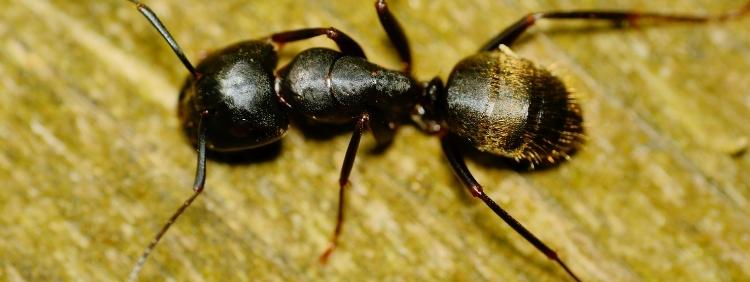Guelph Pest Control: How Many Legs Does a Carpenter Ant Have?

The perception of carpenter ants depends on context, i.e., where they are found. When they remain in the wild, they are seen as beneficial creatures that help to break down dead tree stumps and fallen logs. However, if they make their way into houses, they can cause significant property damage and require carpenter ant pest control in Guelph to remove.
Like other insects, carpenter ants have six legs unless they meet with some accident in which they lose one. Their legs are part of the reason for some of their remarkable abilities.
Anatomy
Each of the carpenter ant’s six legs is segmented with three separate joints. Each leg connects to the thorax, which is the middle portion of an ant’s body. An ant’s legs are very strong, allowing it to lift several times its body weight. The strength of an ant’s legs also makes it very fast. To put an ant’s speed into perspective, a human being with legs like an ant’s could reach running speeds rivalling that of a racehorse.
At the tip of each of a carpenter ant’s legs is a hooked claw. At times, this works like a cleat on an athlete’s shoe, helping the ant to get traction on the surface so it can propel itself forward more effectively. At other times, it works like an ice axe used by rock climbers, allowing the ant to anchor itself as it climbs up a steep surface.
Locomotion
Ants get around by a process called locomotion, or alternating tripod gait. In other words, they divide their six legs into two groups of three. When an ant is in motion, at any given time three of its legs are on the ground, supporting it, and three of its legs are in the air, getting ready to propel the ant forward.
If you’ve ever seen an ant walk, you know that it’s not the three legs on each side that are part of the same group. This would give the ant a lumbering, awkward gait and would make it less stable while it was in motion. Instead, each of the groups consists of two legs on one side and one leg on the other. When each group of three legs is on the ground, it works like a tripod or a three-legged table to support the ant’s body and give it stability.
This method of alternating tripod gait not only keeps the ant stable but also gives it more agility, allowing it to change direction quickly to avoid an obstacle or a threat. This is what gives ants their distinctive scuttling gait as they move around and is also part of the reason why an ant can run so quickly.
Other Uses
Ants use their legs for other things besides walking, running, and climbing. They also have touch receptors on their feet and along their legs. The receptors on the legs resemble very fine hairs. The touch receptors in the feet are very sensitive and help the ant to navigate more effectively over whatever surface they are travelling along.
Ants also use the touch receptors in their legs to communicate with one another. Using their forelegs to pat the body of another ant, they use their touch receptors to gain information. Ants also communicate with one another using sound, which they may make by rubbing their legs against a part of their body that has a lumpy surface like a washboard. This is similar to the way that crickets make sounds but, unlike crickets chirping, the sounds that ants make in this fashion are ultrasonic, meaning that they are too high for humans to hear.
Call Truly Nolen for Carpenter Ant Pest Control in Guelph
Carpenter ants are fascinating, but when they infest your home, they become a dangerous nuisance. The longer they remain, the more damaging they can become, so contact Truly Nolen at the first sign of carpenter ants.